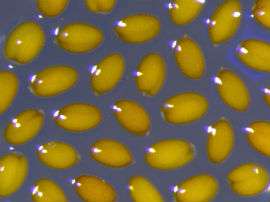How seeds recognise the seasons

Scientists at the University of York have played a key role in new research into the way 'mother' plants use their memory of the seasons to teach their seeds the most advantageous time to germinate.
Researchers led by Professor Ian Graham, of the Centre for Novel Agricultural Products (CNAP) in York's Department of Biology, working with scientists at the University of Exeter, found that the mother plant senses temperature and forms a long term temperature memory.
Using Arabidopsis thaliana as a model plant, they found its temperature memories enable progeny seeds to determine the time of year and modify their germination rates to ensure their growth and development is coordinated with the seasons.
If the mother experiences warmer temperatures, it produces more of a protein called Flowering Locus T (FT) which represses production of tannins in the fruit, making seed coats thinner and more permeable. This means they germinate more quickly.
Conversely, if the mother plant experiences cooler temperatures before flowering, it produces less FT protein and more tannins. Seed coats will be thicker and less permeable and will germinate later. In this way, the mother plant can manipulate seed germination to be optimal for the time of year.
With climate change making suboptimal conditions more frequent, a better understanding how plants communicate with their seeds will help scientists optimise seed quality for crops and domestic use.
CNAP researchers measured the hormones in seeds which usually control germination but, in this case, they found that other signals coming from the mother plant were more important.
The research funded by the Biotechnology and Biological Sciences Research Council (BBSRC) and the Royal Society has implications for improving crop yields by helping scientists and growers to adapt how crops respond to changes in climate and temperature. It is published in Proceedings of the National Academy of Sciences (PNAS).
Professor Graham said: "This work demonstrates the importance of growing conditions throughout the lifecycle of the plant. In terms of crop plants, it highlights how adverse environmental conditions can have a negative impact on seed quality."
Dr Steven Penfield, now of the John Innes Centre in Norwich, who led the research, said: "By understanding how the mother plant uses temperature information to influence the vigour of her seeds we can begin to develop strategies for breeding seeds with more resilience to climate change."
The FT protein is known to influence when a plant flowers depending on the length of day. The research also showed that the influence of this protein on seed dormancy was entirely separate from its influence on flowering time.
More information: Maternal temperature history activates Flowering Locus T in fruits to control progeny dormancy according to time of year, PNAS, www.pnas.org/cgi/doi/10.1073/pnas.1412274111
Journal information: Proceedings of the National Academy of Sciences
Provided by University of York



















